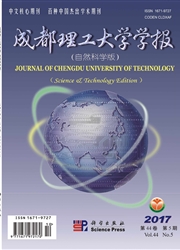

 中文摘要:
中文摘要:
探讨川西北地区晚三叠世卡尼期马鞍塘组下部的鲕粒灰岩的沉积相及沉积时的古气候、古盐度。在前人研究成果基础上,对绵竹县汉旺观音崖剖面开展野外调查和室内薄片鉴定及碳氧同位素测试,结果表明共发育3套鲕粒灰岩,主要沉积于碳酸盐缓坡,由下到上鲕粒以复鲕、同心鲕、放射同心鲕、脑状鲕呈现,展示鲕粒沉积时海水能量降低、水体逐渐加深的趋势;上部灰岩中脑状鲕与同心鲕共存且同心鲕具双峰态粒度分布,显示鲕粒沉积时受到风暴作用影响。碳、氧同位素测试显示,鲕粒灰岩沉积时的古温度大体在24~35℃,Z值在127~131,表明在卡尼期早期,川西北地区以蒸发量较高的低纬度地区干热气候为主。
 英文摘要:
英文摘要:
Sedimentar in the lower part of y facies, paleoclimate and paleosalinity of late Triassic Carnian oolitic limestone Ma'antang Formation, northwest Sichuan Basin are studied based on former achievements, field investigation and sedimentary facies analysis. The Carnian limestone section is composed of three parts, occurred as composite oolite, concentric oolite, radial-concentric oolite and brain-like oolite from the bottom to top, and they are mainly deposited on carbonate ramps under the condition of decreased seawater energy and deep sea water. However, the coexistence of brain-like oolite and concentric oolite on the top of the limestone and the bimodal size distribution of concentric oolite reveal that the formation of oolites is affected storm during the deposition. According to the analysis of δ^18O and δ^13C, the paleotemperature is 24-35℃ and the Z value is 127-131 during the deposition of oolitic limestone. It implies that the northwest Sichuan Basin was an area with high evaporation and low latitudes and characterized by hot dry climates in early Carnian of the late Triassic. Oolitic limestone in the area is of great importance in the analysis and reconstruction of paleogeography and paleotemperature.
 同期刊论文项目
同期刊论文项目
 同项目期刊论文
同项目期刊论文
 期刊信息
期刊信息
